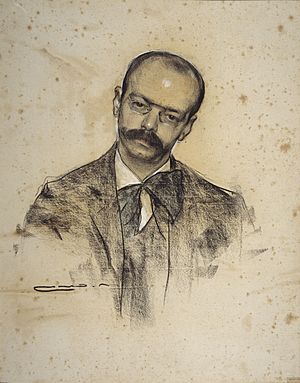Gabriel Alomar i Villalonga facts for kids

Gabriel Alomar (born in 1873, died in 1941) was an important Spanish poet, essay writer, teacher, and diplomat in the early 1900s. He was connected to a special art movement in Catalonia called Modernisme. Alomar was a strong supporter of freedom and left-wing ideas, especially in Barcelona and other areas where people spoke Catalan. He continued his work until he passed away from pneumonia while living away from his home country (in exile).
Contents
Early Life and Education
Gabriel Alomar was born in Palma, a city on the Balearic Islands. These islands were a traditional part of Spain where the Catholic Church had a lot of power. His father worked for the government, which meant the family moved around quite a bit. This gave Gabriel a more diverse childhood than most Spanish kids at the time.
In 1888, after finishing secondary school in Palma, Alomar moved to mainland Barcelona. Many young men from Mallorca did this to continue their education. In Barcelona, he started working as a journalist and kept writing poetry. He also became involved in the Catalan regionalist movement, which aimed to give more power to the Catalan region. He was also part of a literary style called noucentisme.
Gabriel Alomar's Poetry
Some critics group Gabriel Alomar with the poets of the Escola Mallorquina, a group from Mallorca. However, this isn't a perfect fit. While Alomar's poetry followed traditional rules of form, its ideas were different from the very religious beliefs of other poets in that group.
A better way to describe his poetry is to link it to the Parnassianist style within the Modernisme movement. Even though Alomar's poems were well-liked in his home area of Mallorca, it is his essays and journalism that are still widely read and published today.
Journalism and Futurism
Alomar's writings for newspapers and magazines were less about simple reporting and more about sharing strong opinions in a column style. His columns often sounded like speeches. This makes sense because he was a teacher and a secondary school director, and many of his articles started as lectures.
His most famous speech-article was called El futurisme. In this piece, Alomar shared his ideas about Spain's problems and how to fix them. He is actually credited with inventing the term futurism and some of its ideas, even before the Italian poet Filippo Tommaso Marinetti. Famous poets like Rubén Darío and Vicente Huidobro have noted this discovery.
Alomar believed that Spain was too focused on its past. He felt that Spain preferred to dream about its old imperial glory instead of looking forward to the twentieth century. For Alomar, the future was much more important than the past, and he saw this focus on the past as Spain's main problem. That's why he called his idea "futurism."
A Diplomat for Spain
Gabriel Alomar also served as a diplomat for Spain. He was the Spanish Ambassador to Italy from 1932 to 1934. Later, he became the Ambassador to Egypt in 1937, staying there until the end of the Spanish Civil War. He remained in Cairo, Egypt, until he passed away in 1941.
Lasting Influence
Gabriel Alomar had many different jobs throughout his life. He was always asked to write prologues (introductions) for books. He wrote dozens of them in Spanish, Catalan, and French. He wrote introductions for famous writers and also for young authors who needed a helpful start.
See also
In Spanish: Gabriel Alomar para niños

